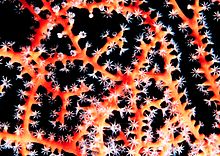
Back Blomdier Afrikaans زهريات شعاعية Arabic زهريات شعاعيه ARZ Mərcan polipləri Azerbaijani Anthozoa BAN Каралавыя паліпы Byelorussian Корали Bulgarian Antozoared Breton Korali BS Antozous Catalan
| Anthozoa Temporal range: Late Ediacaran to recent
| |
|---|---|

| |
| Coral outcrop on the Great Barrier Reef | |

| |
| Gorgonian with polyps expanded | |
| Scientific classification | |
| Domain: | Eukaryota |
| Kingdom: | Animalia |
| Phylum: | Cnidaria |
| Subphylum: | Anthozoa Ehrenberg, 1834 |
| Subclasses | |
Anthozoa is a class of marine invertebrates which includes sessile cnidarians such as the sea anemones, stony corals, soft corals and sea pens. Adult anthozoans are almost all attached to the seabed, while their larvae can disperse as planktons. The basic unit of the adult is the polyp; this consists of a cylindrical column topped by a disc with a central mouth surrounded by tentacles. Sea anemones are mostly solitary, but the majority of corals are colonial, being formed by the budding of new polyps from an original, founding individual. Colonies are strengthened by calcium carbonate and other materials and take various massive, plate-like, bushy or leafy forms.
Members of Anthozoa possess cnidocytes, a feature shared among other cnidarians such as the jellyfish, box jellies and parasitic Myxozoa and Polypodiozoa. The two main subclasses of Anthozoa are the Hexacorallia, members of which have six-fold symmetry and includes the stony corals, sea anemones, tube anemones and zoanthids; and the Octocorallia, which have eight-fold symmetry and includes the soft corals and gorgonians (sea pens, sea fans and sea whips), and sea pansies. The smaller subclass, Ceriantharia, consists of the tube-dwelling anemones. Some additional species are also included as incertae sedis until their exact taxonomic position can be ascertained.
Anthozoans are carnivores, catching prey with their tentacles. Many species supplement their energy needs by making use of photosynthetic single-celled algae that live within their tissues. These species live in shallow water and many are reef-builders. Other species lack the zooxanthellae and, having no need for well-lit areas, typically live in deep-water locations.
Unlike other members of this phylum, anthozoans do not have a medusa stage in their development. Instead, they release sperm and eggs into the water. After fertilisation, the planula larvae form part of the plankton. When fully developed, the larvae settle on the seabed and attach to the substrate, undergoing metamorphosis into polyps. Some anthozoans can also reproduce asexually through budding or by breaking in pieces.